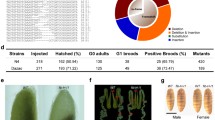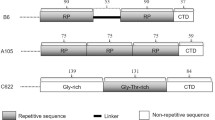Abstract
Large-scale production of recombinant spider silk proteins is a long-term goal for their industrial use. Therefore, we have recently developed a process for bacterial production. Due to a highly repetitive gene sequence of spider silks, the host strain E. coli BLR(DE3) was employed since it shows no homologue recombination. Although perfectly suited for production in full media, the BLR strain does not grow in cost-effective minimal media, indicating a previously not reported l-isoleucine auxotrophy. We provide evidence that mutated threonine deaminase is likely responsible for the detected auxotrophy of BLR.
Similar content being viewed by others
Avoid common mistakes on your manuscript.
Introduction
Due to their outstanding properties, spider silk proteins are promising biomaterials for various technical applications (Scheibel 2004; Vendrely et al. 2007). Spider silk combines strength and elasticity unlike any other synthetic or biological material. Due to these outstanding properties the technical use of spider silk materials is partially focused on high performance fibers. No other fiber shows a comparable combination of elasticity and toughness. Therefore, spider silk would be an ideal material for application as surgical sutures among others. Recent developments concerning recombinant production of spider silk proteins enable large-scale production in order to start a new generation of biomaterials (Huemmerich et al. 2004; Scheibel 2004; Vendrely et al. 2007).
Previously, we have employed the E. coli strain BLR(DE3) for producing recombinant spider silk proteins (Huemmerich et al. 2004) by fed-batch techniques (Riesenberg 1991). To lower production costs and to establish a large-scale production process for spider silk proteins, however, deployment of minimal media is essential.
Here, we determine an auxotrophy of the previously employed production strain for recombinant silk proteins, since BLR is unable to produce sufficient amounts of the amino acid l-isoleucine. Further analysis of the biosynthetic pathway of BLR suggests that a mutation in the enzyme threonine deaminase is likely responsible for the detected auxotrophy. Supplementing the media with l-isoleucine bypasses the defective metabolism and allows normal growth in minimal media. Our finding is essential not only for a cost-effective large-scale production of recombinant spider silk proteins, but also for the production of other proteins with highly repetitive sequences.
Materials and methods
Strains
BLR(DE3) (Novagen, USA) is a derivative of BL21(DE3) (Novagen, USA) lacking recombinase A (recA −) activity. BLR(DE3) is further deficient in proteases encoded by lon and ompT. The detailed genotype of E. coli BLR(DE3) has been published by Novagen [F− ompT hsdS B(r −B m −B ) gal dcm (DE3) Δ(srl − recA)306::Tn10 (TetR)].
Sequencing
The threonine deaminase gene of E. coli BL21 and BLR was sequenced (GATC Biotech, Germany) using purified chromosomal DNA of the applied strains and specific oligonucleotides for the threonine deaminase flanking regions. Primer1: GACAAAGCCTGGACGCCG; Primer2: CAGCAGGACGCCCATCTCG; Primer3: GAACCACAAATGACGTTGTCGC.
Bioreactor
For production of spider silk proteins a Biostat-C bioreactor (Sartorius, Germany) with a working volume of 10 l was applied. For process control MFCS software (Sartorius) was used. Aeration: 1 l/min; agitation (Impeller): 100 rpm; pH set point: 6.85; cultivation temperature: 37°C. Cultivation of the bacterial strains took place in glucose based minimal medium (Korz et al. 1995; composition: 25 g glucose, 13.3 g KH2PO4, 4 g (NH4)2HPO4, 1.2 g MgSO4·7H2O, 1.7 g citric acid, 8.4 mg EDTA, 2.5 mg CoCl2·6H2O, 15 mg MnCl2·4H2O, 1.5 mg CuCl2·2H2O, 3 mg H3BO3, 2.5 mg Na2MoO4·2H2O, 13 mg Zinc acetate dihydrate, 100 mg ferric citrate, 4.5 mg thiamine).
Cell growth
Cell growth was monitored at 600 nm. To examine the growth behavior in different media, sterile filtered amino acids (12.5 μg/ml), vitamins (4.5 μg/ml) or fatty acids (1 mg/ml; mix containing: linoleic acid, linolenic acid, oleic acid, butanoic acid, caproic acid, caprylic acid, palmitic acid, stearic acid, myristic acid, lauric acid) were added. For each condition three measurements were performed and averaged.
Results and discussion
In BLR, target plasmids containing repetitive sequences, such as spider silk genes, do not undergo homologue recombination allowing expression of full-length constructs. The growth of BLR(DE3) in full medium, i.e. in Luria broth medium, has been successfully employed and previously described (Khushoo et al. 2005; Ham et al. 2006).
Surprisingly, E. coli BLR(DE3) barely grows in minimal media (MM) (Daisuke et al. 2001 and Fig. 1). However, supplementing MM with small amounts of yeast extract resulted in growth-rates comparable to those in Luria broth full medium (Fig. 1).
(A) Growth of E. coli BLR(DE3) in minimal medium during a cultivation process. Arrow: addition of yeast extract. (B) E. coli BLR(DE3) growth in minimal medium (MM) and with selected additives. Not supplemented MM (−) was used as a negative control, MM supplemented with yeast extract (YE) as positive control. FA: fatty acids. Upon growth in YE, OD600 = 1.4 was reached after 20 h cultivation time. This value was set to 100%. (C) E. coli BLR(DE3) growth in MM supplemented with amino acids. Mixtures containing five amino acids each or single amino acids were added to MM, respectively. YE: yeast extract, AA: amino acid. The single letter code for amino acids has been used. The optical density OD600 = 1.4 upon growth (20 h) in YE was set to 100%
Since it is likely that the growth rate defect is based on an auxotrophy, we investigated this phenomenon more closely. BLR(DE3) was incubated in MM supplemented with specific additives (amino acids, vitamins or fatty acids) for 20 h at 37°C. Both, the presence of yeast extract or tryptone yielded exponential growth, while addition of vitamins or fatty acids had no effect (Fig. 1B). A closer examination revealed that growth depended on the presence of the single amino acid l-isoleucine (Fig. 1C). Therefore, E. coli BLR(DE3) comprises a previously not detected l-isoleucine auxotrophy.
E. coli BLR strains are derived from E. coli BL21, which reveals no amino acid auxotrophy (Paliy and Gunasekera 2007 and data not shown). It has been reported by Novagen that the genotypes of both strains differ only in a single deletion (Δ(srl − recA)306::Tn10 (TetR)), which is caused by a transposon unlikely being the cause for the isoleucine auxotrophy.
Therefore, the biosynthesis of isoleucine, in which l-threonine is the precursor of l-isoleucine, was further examined. Except for threonine deaminase (TD, threonine dehydratase), which catalyzes the reaction from l-threonine to α-oxobutanoate, l-isoleucine biosynthesis uses the same enzymes as are used for the biosynthesis of l-valine (Fig. 2). Since supplementation of MM with l-valine or with l-threonine (Fig. 1C) had no effect on growth, TD is most likely the defective enzyme of BLR(DE3).
Schematic view of l-isoleucine biosynthesis. Threonine deaminase is the only enzyme which is involved in the biosynthesis of l-isoleucine, but not in the biosynthesis of l-valine. Therefore, threonine deaminase is most likely the cause for the detected isoleucine auxotrophy. (Figure adapted from http://www.biocyc.org)
This hypothesis is strongly supported by the fact, that the commercially available BLR strain exhibits a single point mutation within the catalytic domain of TD. TD is a homotetramer with four highly conserved catalytic sides (Fig. 3). Sequence analysis revealed, that a cysteine residue of TD at position 219, as found in BL21, is replaced by a tyrosine residue in TD of BLR. Residue 219 is located within helix 9, which resembles one wall of the binding site of the essential cofactor pyridoxal 5′-phosphate (PLP) (Gallagher et al. 1998). According to the drastic change in hydrophobicity and to the increased sterical hindrance due to the given point mutation, it is most likely that the catalytic cleft of TD from BLR shows lower affinity and specificity for PLP than the wildtype TD of BL 21 and, therefore, a lower activity.
Since TD is only essential for viability of BLR when grown on minimal medium, the auxotrophy has previously not been reported. However, such knowledge is essential to develop a cost-effective production system for proteins with highly repetitive gene sequences such as spider silks.
References
Daisuke K, Kensaku S, Saori S et al (2001) Shifted positioning of the anticodon nucleotide residues of amber suppressor tRNA species by Escherichia coli arginyl-tRNA synthetase. Eur J Biochem 268:6207–6213
Gallagher DT, Gilliland GL, Xiao G et al (1998) Structure and control of pyridoxal phosphate dependent allosteric threonine deaminase. Structure 6(4):465–475
Ham TS, Lee SK, Keasling JD et al (2006) A tightly regulated inducible expression system utilizing the fim inversion recombination switch. Biotechnol Bioeng 94(1):1–4
Huemmerich D, Helsen CW, Oschmann J et al (2004) Primary structure elements of dragline silks and their contribution to protein solubility and assembly. Biochemistry 43:13604–13612
Khushoo A, Pal Y, Mukherjee KJ (2005) Optimization of extracellular production of recombinant asparaginase in Escherichia coli in shake-flask and bioreactor. Appl Microbiol Biotechnol 68(2):189–197
Korz DJ, Rinas U, Hellmuth K et al (1995) Simple fed-batch technique for high cell density cultivation of Escherichia coli. J Biotechnol. 39(1):59–65
Paliy O, Gunasekera TS (2007) Growth of E. coli BL21 in minimal media with different gluconeogenic carbon sources and salt contents. Appl Microbiol Biotechnol 73(5):1169–1172
Riesenberg D (1991) High-cell-density cultivation of Escherichia coli. Curr Opin Biotechnol 2:380–384
Scheibel T (2004) Spider silks: recombinant synthesis, assembly, spinning and engineering of synthetic proteins. Microb Cell Fact 3:14–24
Vendrely C, Scheibel T (2007) Biotechnological production of spider silk proteins enables new applications. Macromol Biosci 7:401–409
Acknowledgements
We thank Christian Ackerschott and Christian Patzig for experimental support. This work is supported by the DFG (SCHE 603/4-2).
Author information
Authors and Affiliations
Corresponding author
Additional information
M. Schmidt and L. Römer contributed equally to this work.
Rights and permissions
About this article
Cite this article
Schmidt, M., Römer, L., Strehle, M. et al. Conquering isoleucine auxotrophy of Escherichia coli BLR(DE3) to recombinantly produce spider silk proteins in minimal media. Biotechnol Lett 29, 1741–1744 (2007). https://doi.org/10.1007/s10529-007-9461-z
Received:
Revised:
Accepted:
Published:
Issue Date:
DOI: https://doi.org/10.1007/s10529-007-9461-z







